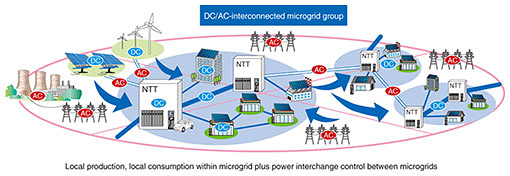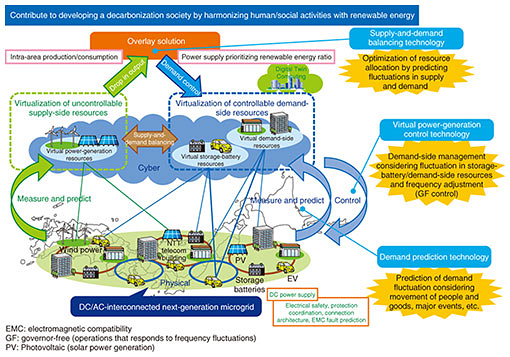 |
|||||||||||||||
|
|
|||||||||||||||
|
Feature Articles: NTT Group Initiatives for Environment and Energy Vol. 18, No. 7, pp. 16–22, July 2020. https://doi.org/10.53829/ntr202007fa3 Future Energy TechnologiesAbstractThe NTT Group is promoting measures to address the rapidly changing situation surrounding energy. To contribute to this effort, NTT Network Technology Laboratories (NTT Space Environment and Energy Laboratories at present) has begun research in the area of energy distribution and is moving forward on research and development related to providing electric power services that use renewable energy while maintaining the same quality as commercial power supply. This article provides an overview of this research and development, and describes the NTT Group’s efforts to promote future energy business. Keywords: DC transmission/distribution, virtual energy-distribution platform, IOWN 1. Energy issues of JapanHow best to use limited energy resources in the years to come has become a worldwide issue, and the last few years have seen dramatic changes in the energy situation. Japan is faced with the following three main energy issues: (1) Response to the international environmental framework (The Paris Agreement, etc.) (2) Energy security (reduce energy dependency on overseas sources) (3) National resilience in energy (construct an infrastructure robust against disasters) A breakdown of Japan’s primary energy supply is shown in Fig. 1 [1]. Among the various forms of energy used, primary energy refers to energy that is directly obtained from nature, such as coal, oil, liquefied natural gas (LNG), hydroelectric power, nuclear power, wind power, geothermal power, and solar energy. In Japan, dependency on fossil fuels has been increasing due to a reduction in nuclear power generation since the Great East Japan Earthquake of 2011, and today, approximately 90% of Japan’s primary energy supply is made up of coal, oil, and LNG. The use of fossil fuels increases carbon dioxide (CO2) emissions, which makes it difficult to work within the international environmental framework in issue (1) above.
The primary energy self-sufficiency ratios for major nations are shown in Fig. 2. The energy self-sufficiency ratio of resource-poor Japan is less than 10%, despite using a large amount of energy. It can therefore be inferred that securing primary energy sources in the event of an international emergency or future depletion of natural resources would be difficult, resulting in insufficient motive and electric power. There is also a need to prevent power losses, e.g., a blackout*1, during a disaster and long-term power outage such as those that occurred in Hokkaido and Chiba prefectures in 2019.
To address these issues, it will be necessary to increase the ratio of renewable energy to the total amount of power used in Japan and to both reduce CO2 emissions and increase the country’s energy self-sufficiency ratio.
2. Energy business in the NTT Group and related research and developmentConsuming approximately 1% of Japan’s power, the NTT Group bears much responsibility in the use of energy. To help address social issues related to the environment and energy, NTT established NTT Anode Energy in June 2019 as a company overseeing energy-related business in the NTT Group. This company aims to develop smart energy businesses [2] that will combine expertise in existing NTT Group telephone exchanges, infrastructure facilities, direct-current (DC) transmission/distribution, storage batteries, etc. with an information and communication technology (ICT) platform. The business lineup of NTT Anode Energy is shown in Fig. 3. The NTT Group plans to enter the energy business on a broad scale including green-power generation, backup-power supply, and electricity retailing to sell energy and provide energy services to other companies in addition to promoting energy measures within the Group. It also plans to actively invest in distributed energy platforms related to renewable energy (such as solar power and wind power), storage batteries, and electric vehicles (EVs).
We next introduce research and development (R&D) in the energy field at NTT Network Technology Laboratories (NTT Space Environment and Energy Laboratories at present). 3. NTT energy researchAn overview of NTT’s research in the energy field is shown in Fig. 4. Our research policy is to contribute to addressing Japan’s energy issues and expanding NTT Group’s energy business. Therefore, we aim to make maximum use of DC technologies and micro energy to construct sustainable communication networks and lifelines robust against long-term power outages caused by natural disasters and other factors.
Specifically, we are researching and developing next-generation microgrid technology to make the best use of renewable energy without waste and achieve regional energy interchange and resilience, virtual energy-distribution platform technology, which features a virtual power generation function of several hundred megawatts that can monitor, measure, and control several hundreds of thousands of power resources scattered throughout Japan and respond within several seconds (a feature that other operators have been unable to achieve), and micro energy utilization technology, which enables communications unrestricted by place, condition, etc. 3.1 Next-generation microgrid technologyA next-generation microgrid*2 refers to a low-cost and simple regional microgrid that introduces DC technology in a stepwise and safe manner to promote energy self-sufficiency in the region and support municipal and corporate business continuity planning. The concept of the next-generation microgrid is shown in Fig. 5. This grid uses assets such as storage batteries in NTT’s telecom buildings, and the power is interchanged among consumers within the grid. The objective is to construct a DC/alternating current (AC)-interconnected microgrid that has the advantages of both commercial power and DC power output from renewable energy sources and storage batteries within the grid and that can interchange both types of power. To this end, we will first need to research and develop a DC transmission/distribution system architecture and means of ensuring the electrical safety of this system, both of which are important elements of a DC/AC-interconnected microgrid.
(1) DC/AC-interconnected microgrid architecture To investigate a DC/AC-interconnected microgrid architecture, we are researching technologies for interchanging power between suppliers and consumers in an area. These include load-sharing and power-interchanging control technologies that take into account the characteristics of DC distribution cables, storage batteries, power conditioners, power-conversion equipment, etc., as well as the response speed and demand-fluctuation characteristics of such constituent elements. Furthermore, to establish a microgrid architecture that can provide necessary and sufficient stability while taking into account innovative information-communication network architecture of the future and changing reliability in commercial power supplies due to recent climate change, we will study methods of optimizing the balance between reliability and total cost of ownership (TCO)*3. (2) Electrical safety technologies for DC transmission/distribution A DC transmission/distribution system for outdoor delivery of power is highly susceptible to surge current/voltage caused by lightning and must therefore incorporate appropriate countermeasures. The occurrence of electrical leakage due to aging of the DC transmission/distribution system or unforeseen faults must also be considered. We will therefore construct test systems in actual buildings to collect data with the aim of establishing technologies for countering direct lightning strikes and lightning-induced surges and for detecting faults for the target network topology as electrical safety technologies for DC-transmission/distribution. 3.2 Virtual energy-distribution platform technologyA virtual energy-distribution platform is an energy platform for linking and controlling physical energy resources across Japan and virtual-power-generation and demand-side resources to contribute to the creation of a decarbonized society by harmonizing human/social activities with renewable energy. It is a platform for accepting supplies of renewable energy while maintaining the quality of electricity supply equivalent to that via the transmission and distribution networks of major electric power companies. The concept of a virtual energy-distribution platform is shown in Fig. 6. Since the amount of power generated by renewable energy changes rapidly according to weather conditions and other factors, the aim is to maintain the quality of electricity supply through large-scale, fast-responding virtual power plant (VPP)*4 control technology that performs optimal control of storage-battery and demand-side resources within the platform. We are also working on high-accuracy demand-prediction technology for predicting demand volume by taking into account the movement of people and goods, major events, etc.
(1) Large-scale, fast-responding VPP control technology We aim to establish technology for carrying out optimal and immediate allotment and control of power resources by modeling the input/output characteristics of the energy creation/storage equipment group such as instantaneously changing renewable energy, storage batteries, etc. and by modeling the input/output characteristics of the power-demand group such as network equipment. We will also investigate technology for configuring a VPP on a scale of several hundred megawatts with a fast response performance and electricity quality control by integrating power resources via a nationwide ultra-high-speed network. (2) Integrated energy supply-and-demand balancing technology We aim to establish large-scale peer-to-peer energy trading technology supporting several hundreds of thousands of supply-and-demand devices. This technology will enable request-level optimization and supply-and-demand matching based on power supplies with diverse characteristics and multiple customer policies while comparing diverse types of request timing and composite request values with procurable electricity. (3) Quasi-real-time supply-and-demand prediction technology In addition to enhancing the accuracy of existing solar/wind power-generation prediction based on weather information and that of demand prediction for each service area, we aim to establish technology for making quasi-real-time predictions of local supply-and-demand fluctuations affected by the flow of people and goods (data possessed by the NTT Group), community events, and EV usage. 3.3 Micro-energy utilization technologyWe are investigating systems for extracting and storing micro amounts of energy in the peripheral environment (light, pressure, etc.) and using that energy after a certain amount accumulates (analogous to a Japanese shishi-odoshi water fountain in which a hallow bamboo branch on a pivot slowly fills with water until the amount of water is enough to tip the branch and dump out the water). As a means of addressing environment and energy issues, we are working on artificial photosynthesis technology for generating useful substances from sunlight by mimicking photosynthesis in plants. To establish such technologies, we are looking to use semiconductor growth technologies and catalyst technologies that have supported the information-communications field. (1) Optical-energy high-efficiency utilization technology To improve the resilience of the All-Photonics Network, we are investigating technology for using micro optical energy as efficiently as possible in a safe manner. Specifically, we are researching basic technology for separating the optical energy transmitted along with communications data, converting it to other forms of energy, and using it efficiently by taking into account usage conditions during a power outage. (2) Micro-energy creation and storage technology We will conduct basic research on micro-energy creation that extracts the micro energy all around us in the form of vibrations, heat, static electricity, etc. and increases its density. We will also research micro-energy storage for using such micro-energy-creation technology and wearable technology. We will research and develop energy-storage/discharge technologies that use accessories such as clothes, belts, eyeglasses, and terminals. 3.4 IOWNIn the R&D projects described above, a high-speed, low-latency, and high-functional network is essential to controlling and operating energy resources. NTT has proposed the Innovative Optical and Wireless Network (IOWN) [3] and is currently working toward its implementation. IOWN consists of three main components: the All-Photonics Network that introduces optical processing not only for the network but also terminals; Digital Twin Computing that enables sophisticated and real-time interaction between things and people in cyberspace; and Cognitive Foundation® that efficiently deploys a variety of ICT resources. To maintain quality of electricity under large-scale, fast-responding VPP control, high-speed and low-latency communications is necessary to determine and control the state of energy resources in real time. There is also a need for an operation system with dramatically higher functionality than current systems to control from several million to several tens of millions of energy resources. In our energy research, we plan to study energy-system requirements and implement them in a new network as an important use case of IOWN.
4. Future developmentsGoing forward, we will promote R&D that can contribute to the growth of NTT’s energy business in collaboration with NTT Group companies. References
|
|||||||||||||||
















